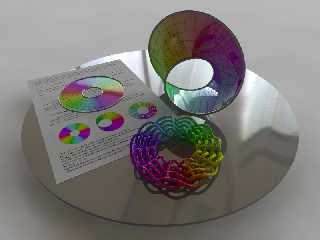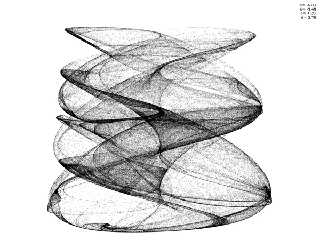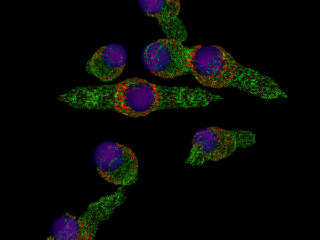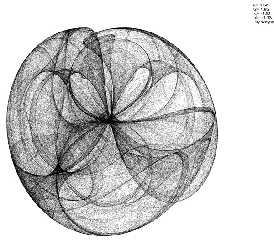 |
 |
|
 |
|
 |
|  |
|  |
|
 |
|
 |
|  |
|  |
|
 |
I used PovRay to create a number of illustrations for a Vision Research
paper
http://astronomy.swin.edu.au/~pbourke/papers/visres/visres.pdf
Most of the images where very harsh crisp colour, orthographic cameras,
minimal lighting, no shadows, etc. Not terribly satisfying .... here's a
page from the paper with one of those diagrams and the geometry the way it
was supposed to be seen. :-)
Post a reply to this message
Attachments:
Download '3.jpg' (309 KB)
Preview of image '3.jpg'

|
 |
|  |
|  |
|
 |
|
 |
|  |
|  |
|
 |
Very nice! (now teach all math book illustrators to use POV :-))
One question: How did you make the plateau? It looks very much like brushed
metal.
JWV
"Paul Bourke" <pdb### [at] swin edu edu au> wrote in message
news:web.445b105c943c07666d08de0a0@news.povray.org...
> I used PovRay to create a number of illustrations for a Vision Research
> paper
> http://astronomy.swin.edu.au/~pbourke/papers/visres/visres.pdf
> Most of the images where very harsh crisp colour, orthographic cameras,
> minimal lighting, no shadows, etc. Not terribly satisfying .... here's a
> page from the paper with one of those diagrams and the geometry the way it
> was supposed to be seen. :-)
>
----------------------------------------------------------------------------
---- au> wrote in message
news:web.445b105c943c07666d08de0a0@news.povray.org...
> I used PovRay to create a number of illustrations for a Vision Research
> paper
> http://astronomy.swin.edu.au/~pbourke/papers/visres/visres.pdf
> Most of the images where very harsh crisp colour, orthographic cameras,
> minimal lighting, no shadows, etc. Not terribly satisfying .... here's a
> page from the paper with one of those diagrams and the geometry the way it
> was supposed to be seen. :-)
>
----------------------------------------------------------------------------
----
Post a reply to this message
|
 |
|  |
|  |
|
 |
|
 |
|  |
|  |
|
 |
Paul Bourke spake:
> I used PovRay to create a number of illustrations for a Vision Research
> paper
> http://astronomy.swin.edu.au/~pbourke/papers/visres/visres.pdf
> Most of the images where very harsh crisp colour, orthographic cameras,
> minimal lighting, no shadows, etc. Not terribly satisfying .... here's a
> page from the paper with one of those diagrams and the geometry the way it
> was supposed to be seen. :-)
Nice - has got a soft edged look that is quite appealing to me.
--
Stefan Viljoen
Software Support Technician / Programmer
Polar Design Solutions
Post a reply to this message
|
 |
|  |
|  |
|
 |
|
 |
|  |
|  |
|
 |
> Paul Bourke spake:
>
> > I used PovRay to create a number of illustrations for a Vision Research
> > paper
> > http://astronomy.swin.edu.au/~pbourke/papers/visres/visres.pdf
I just stumbled upon this posting because I saw science metnionned. Nice.
In fact, I stumbled upon your web site last week when trying to learn about
fractals. I ended up coding PovRay to make those intriguing Peter De Jong
Attractor graphs you have at your site. One image is below. Because I set
it up to randomly assign the a,b,c,d vlaues, I added the a,b,c,d values in
the corner so I could remake them if I want.
Thanks for making math fascinating and elegant.
Wayne
Post a reply to this message
Attachments:
Download 'de jong attractors made into point fields06.jpg' (155 KB)
Preview of image 'de jong attractors made into point fields06.jpg'

|
 |
|  |
|  |
|
 |
|
 |
|  |
|  |
|
 |
I forgot to add that I ended up using fractals to make what looks like
epithelial cells seen by Cell biology techniques (see below). This is what
lead me to your site because I was hoping to understand the math more. But
then I saw those aesthetically pleasing Peter De Jong Attractor curves and
had to learn about that.
Plus at your site I found more help with making a baseball, in the form of a
formula for baseball seams, so your site has been really helpful.
Thanks,
Wayne
Post a reply to this message
Attachments:
Download 'lots of fake epithelial cells.jpg' (136 KB)
Preview of image 'lots of fake epithelial cells.jpg'

|
 |
|  |
|  |
|
 |
|
 |
|  |
|  |
|
 |
> I just stumbled upon this posting because I saw science metnionned. Nice.
> In fact, I stumbled upon your web site last week when trying to learn about
> fractals. I ended up coding PovRay to make those intriguing Peter De Jong
> Attractor graphs you have at your site. One image is below. Because I set
> it up to randomly assign the a,b,c,d vlaues, I added the a,b,c,d values in
> the corner so I could remake them if I want.
Readers might like to note that while this "looks" like a 3D model
and it was created using PovRay (a 3D rendering package), it is in fact
only 2D ... it's our brain that prefers to make sense of the twirls as
a 3D object.
--
Paul Bourke
pdb(NOSPAM)swin.edu.au
Post a reply to this message
|
 |
|  |
|  |
|
 |
|
 |
|  |
|  |
|
 |
Paul Bourke <pdb### [at] swin edu edu au> wrote:
> Readers might like to note that while this "looks" like a 3D model
> and it was created using PovRay (a 3D rendering package), it is in fact
> only 2D ... it's our brain that prefers to make sense of the twirls as
> a 3D object.
>
> --
> Paul Bourke
> pdb(NOSPAM)swin.edu.au
These attractor plots seem to be much different then your tree attractors
where the particle comes in and gets stuck as it builds? Why is it called
Peter De Jong 'attractors'?
After getting my coding to work I found J. Tarbell's site where he creates
the 2-D Peter De Jong plots
(http://www.complexification.net/gallery/machines/peterdejong/) using
processing in an animated (and much faster method and able to handle more
without memory problems/strange error problems Povray spits out for certain
values of a,b,c,d and number of points) using the program Processing. I
would have missed out on the thrill of getting it working on my own had I
found that first. I was glad to see his code was very similar to mine, but
he had a line in his that looks like it changes d value as it goes along
but I couldn't note any changes with that line commented out.
Here is that line in the code:
float d = sqrt((xn-x)*(xn-x) + (yn-y)*(yn-y));
and here is the code segement it is in
void draw() {
// move through time
xn = sin(a*y) - cos(b*x);
yn = sin(c*x) - cos(d*y);
float d = sqrt((xn-x)*(xn-x) + (yn-y)*(yn-y));
x = xn;
y = yn;
// render single transparent pixel
stroke(0,5);
point((x/gs+gx)*dim,(y/gs+gy)*dim);
Any ideas what this would do?
The other odd thing is that in the first image J. Tarbell posts there at his
site where he gives the a,b,c,d values (a=-1.793 b=-0.2958 c=-2.315
d=0.4081) those values makes my povray program spit out an error while
others that you (Paul) posted (such as a = 1.4, b = -2.3, c = 2.4, d = -2.1
; at http://astronomy.swin.edu.au/~pbourke/fractals/peterdejong/) work well
and give the same plots as you got. I would guess it is limits of Povray
since my plots look the same using your values;however, maybe it has to do
with altering the d variable as his progresses?
Thanks,
Wayne au> wrote:
> Readers might like to note that while this "looks" like a 3D model
> and it was created using PovRay (a 3D rendering package), it is in fact
> only 2D ... it's our brain that prefers to make sense of the twirls as
> a 3D object.
>
> --
> Paul Bourke
> pdb(NOSPAM)swin.edu.au
These attractor plots seem to be much different then your tree attractors
where the particle comes in and gets stuck as it builds? Why is it called
Peter De Jong 'attractors'?
After getting my coding to work I found J. Tarbell's site where he creates
the 2-D Peter De Jong plots
(http://www.complexification.net/gallery/machines/peterdejong/) using
processing in an animated (and much faster method and able to handle more
without memory problems/strange error problems Povray spits out for certain
values of a,b,c,d and number of points) using the program Processing. I
would have missed out on the thrill of getting it working on my own had I
found that first. I was glad to see his code was very similar to mine, but
he had a line in his that looks like it changes d value as it goes along
but I couldn't note any changes with that line commented out.
Here is that line in the code:
float d = sqrt((xn-x)*(xn-x) + (yn-y)*(yn-y));
and here is the code segement it is in
void draw() {
// move through time
xn = sin(a*y) - cos(b*x);
yn = sin(c*x) - cos(d*y);
float d = sqrt((xn-x)*(xn-x) + (yn-y)*(yn-y));
x = xn;
y = yn;
// render single transparent pixel
stroke(0,5);
point((x/gs+gx)*dim,(y/gs+gy)*dim);
Any ideas what this would do?
The other odd thing is that in the first image J. Tarbell posts there at his
site where he gives the a,b,c,d values (a=-1.793 b=-0.2958 c=-2.315
d=0.4081) those values makes my povray program spit out an error while
others that you (Paul) posted (such as a = 1.4, b = -2.3, c = 2.4, d = -2.1
; at http://astronomy.swin.edu.au/~pbourke/fractals/peterdejong/) work well
and give the same plots as you got. I would guess it is limits of Povray
since my plots look the same using your values;however, maybe it has to do
with altering the d variable as his progresses?
Thanks,
Wayne
Post a reply to this message
Attachments:
Download 'peter de jong attractors11.jpg' (202 KB)
Preview of image 'peter de jong attractors11.jpg'

|
 |
|  |
|  |
|
 |
|
 |
|  |
|  |
|
 |
"wayne461" <wde### [at] yahoo com> wrote:
>
> These attractor plots seem to be much different then your tree attractors
> where the particle comes in and gets stuck as it builds? Why is it called
> Peter De Jong 'attractors'?
Forgot to be more specifc. When I wrote 'trees', I meant those fascinating
3D Diffusion limited attractor (DLA) plots. There you aren't plotting
points on a defined curve like the Peter De Jong attractors and there seems
to be that only items 'attracted' to the other parts get to exist. com> wrote:
>
> These attractor plots seem to be much different then your tree attractors
> where the particle comes in and gets stuck as it builds? Why is it called
> Peter De Jong 'attractors'?
Forgot to be more specifc. When I wrote 'trees', I meant those fascinating
3D Diffusion limited attractor (DLA) plots. There you aren't plotting
points on a defined curve like the Peter De Jong attractors and there seems
to be that only items 'attracted' to the other parts get to exist.
Post a reply to this message
|
 |
|  |
|  |
|
 |
|
 |
|  |
|  |
|
 |
"wayne461" <wde### [at] yahoo com> wrote:
Why is it called
> Peter De Jong 'attractors'?
Paul,
You can disregard that question about why called Peter De Jong "attractors."
I found your page http://astronomy.swin.edu.au/~pbourke/fractals/lyapunov/
where it seems to describe how these 'attractors' are found.
"If the Lyapunov exponent is less than zero then the system attracts to a
fixed point or stable periodic orbit. "
However, I am confused a bit later by the list of how the seried can behave,
particular the separation of two possibilities:
"It will form a periodic orbit, these are identified by their negative
Lyapunov exponent "
-and-
"It will exhibit chaos, filling in some region of the plane. These are the
solutions that "look good" and the ones we wish to identify with the
Lyapunov exponent. "
Aren't these the same things because it is "attractors" that you want to
find? Won't the ones that look good have a negative Lyapunov expoenent?
Thanks,
Wayne com> wrote:
Why is it called
> Peter De Jong 'attractors'?
Paul,
You can disregard that question about why called Peter De Jong "attractors."
I found your page http://astronomy.swin.edu.au/~pbourke/fractals/lyapunov/
where it seems to describe how these 'attractors' are found.
"If the Lyapunov exponent is less than zero then the system attracts to a
fixed point or stable periodic orbit. "
However, I am confused a bit later by the list of how the seried can behave,
particular the separation of two possibilities:
"It will form a periodic orbit, these are identified by their negative
Lyapunov exponent "
-and-
"It will exhibit chaos, filling in some region of the plane. These are the
solutions that "look good" and the ones we wish to identify with the
Lyapunov exponent. "
Aren't these the same things because it is "attractors" that you want to
find? Won't the ones that look good have a negative Lyapunov expoenent?
Thanks,
Wayne
Post a reply to this message
|
 |
|  |
|  |
|
 |
|
 |
|  |
|  |
|
 |
"Paul Bourke" <pdb### [at] swin edu edu au> wrote:
> I used PovRay to create a number of illustrations for a Vision Research
> paper
> http://astronomy.swin.edu.au/~pbourke/papers/visres/visres.pdf
> Most of the images where very harsh crisp colour, orthographic cameras,
> minimal lighting, no shadows, etc. Not terribly satisfying .... here's a
> page from the paper with one of those diagrams and the geometry the way it
> was supposed to be seen. :-)
Paul, that's really nice. I have a grant for this summer (o.k., winter for
you) to enhance my on-line Pre-Calculus class -- I'll use Povray for images
and animations. I find myself always trying to decide between quick and
pretty. Personally, I usually opt for pretty (even though I don't always
have a good eye for "pretty"), not just because it's fun, but for
legitimate reasons, like, it increases student interest, and often enhances
understanding. I haven't been pushing it to the extreme of
"photorealistic," but, seeing what you've done, I might just attempt to
raise the bar on a few of my illustrations. au> wrote:
> I used PovRay to create a number of illustrations for a Vision Research
> paper
> http://astronomy.swin.edu.au/~pbourke/papers/visres/visres.pdf
> Most of the images where very harsh crisp colour, orthographic cameras,
> minimal lighting, no shadows, etc. Not terribly satisfying .... here's a
> page from the paper with one of those diagrams and the geometry the way it
> was supposed to be seen. :-)
Paul, that's really nice. I have a grant for this summer (o.k., winter for
you) to enhance my on-line Pre-Calculus class -- I'll use Povray for images
and animations. I find myself always trying to decide between quick and
pretty. Personally, I usually opt for pretty (even though I don't always
have a good eye for "pretty"), not just because it's fun, but for
legitimate reasons, like, it increases student interest, and often enhances
understanding. I haven't been pushing it to the extreme of
"photorealistic," but, seeing what you've done, I might just attempt to
raise the bar on a few of my illustrations.
Post a reply to this message
|
 |
|  |
|  |
|
 |
|
 |
|  |
|
 |




![]()